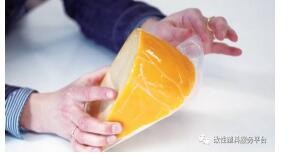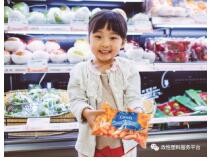At present, the proportion of plastic packaging materials in the total amount of various packaging materials has exceeded 30% , second only to paper products. In China's food packaging materials, the amount of plastics used has exceeded 50% of the total amount of food packaging materials and ranks first among all kinds of packaging materials. So, what are the trends in the development of plastic packaging materials for the food industry? Let's look at a few cases together.
Gradually move from rigid packaging to lighter, more environmentally friendly flexible packaging
Modern food packaging not only provides physical protection for food and content, but also helps extend the shelf life of food, provide product information and display brand image, and is more convenient for consumers to use daily. Compared to other packaging materials and forms, such as glass, metal and hard plastic packaging, soft plastic packaging is more environmentally friendly, saving raw materials and transportation costs, so as to better meet the needs of the modern packaging industry.

Akulon® XS for Food Flexible Packaging Films
According to the forecast of the research agency Smithers Pira, the Asia Pacific region will become the fastest growing consumer soft packaging market in the future.
PacXpertTM is the most advanced packaging technology in the industry. It uses a unique lightweight design. Durable handles designed according to ergonomic principles can help users accurately dump. When vacant, bags can be flat and easy to store and transport. . Although it is called flexible packaging technology, PacXpertTM packaging stands upright and guarantees excellent storage performance, whether placed upright or sideways. Packaging bags using PacXpertTM technology also have a large area of ​​shelf display space, making it easier to "lock in" the consumer's line of sight and make it more attractive to purchase.
In addition, PacXpertTM technology offers considerable environmental benefits. It not only minimizes the waste of packaging contents, but also reduces the consumption of raw materials and increases the product-to-package ratio. In addition to being sought after by customers, Dow PacXpert(TM) technology has captured eight of the world's packaging industry's strength awards since 2013.
Dow PacXpertTM flexible packaging technology has been highly praised since its inception. From Europe to Latin America, from Latin America to Asia-Pacific, PacXpertTM has gradually set off a new trend in flexible packaging around the world. With PacXpertTM technology taking root in China, this will undoubtedly open up a broader application perspective for it, and PacXpertTM technology will also push China's packaging industry from rigid packaging to a lighter, more environmentally friendly flexible packaging.
Food composite packaging film tends to be multifunctional, light and thin
In terms of functional food packaging materials, China’s R&D and production capabilities are still relatively weak. In the future, the demand for functional barrier films such as high barrier, cooking resistance, UV resistance, light protection, antibacterial, breathable, and oxygen-free will continue to increase in the food industry. At the same time, there is a trend towards light and thin development.
ExxonMobil launched two new editions of ExceedTM XP at K 2016 to further expand its product range. These new grades are suitable for shrink flexible packaging and food composite packaging, offering significant performance advantages to film processors and end users.
Exceed XP has been popular with the market since its launch, and customers have reported that the performance level of the product has reached a new level. These new brands reinforce this positive effect. Exceed XP 6026 and Exceed XP 6056 have excellent processing properties, can provide greater toughness, rub resistance, heat sealing performance, balanced shrinkage and good optical properties. For processors, the high melt strength of these polymers enables higher bubble stability and increased yield.

Food packaging film produced with new Exceed XP brand
The food packaging film (including size packaging) produced with the new Excep XP brand has excellent toughness and heat sealing properties, helping brands protect frozen or dry food, meat and cheese products from production to consumption. The melt strength and toughness of Exceed XP can reduce film thickness while maintaining high performance. Processors can take advantage of the exceptional performance and processability of these Exceed XP grades to streamline product inventory and reduce costs .
With the public's increasing awareness of reducing food waste and extending product shelf life, the demand for special barrier films for food flexible packaging has begun to show a continuous upward trend. Today, most barrier film products are often co-extruded through a blown film production line, commonly used in 7-, 9-, or even 11-layer film structures. Polyamide 6 (PA6) has good barrier properties and mechanical strength and is an ideal material for the production of blown film grade food packaging films. However, the high crystallization speed of polyamide 6 limits its processing window. Therefore, processors need to make concessions in terms of production efficiency, or improve the processing performance by mixing polyamide 6 with special amorphous polyamide or polyamide copolymers, but this will make the film cost-effective advantages Great discount.
Akulon® XS developed by DSM solves this problem. This highly cost-effective advanced technology effectively combines barrier properties, printability, heat-sealability and impact resistance. Compared to conventional polyamide 6, Akulon® XS has a much slower crystallization rate in the bubble, giving processors more room to work in processing conditions, allowing them to retain the unique barrier of polyamide 6 and Mechanical properties, more convenient and more efficient production of food flexible packaging film.
Akulon® XS not only has good mechanical strength, puncture resistance and barrier properties, but it can also produce thinner and lighter films, which brings quality and cost advantages and reduces waste.
In addition, EVOH, as a high barrier material, is excellent in gas barrier properties, transparency, gloss, mechanical strength, stretchability, abrasion resistance, cold resistance, and surface strength. In food packaging, EVOH plastic containers can replace glass and metal containers. The EVOH high-barrier resin introduced by Kuraray at the 2016 Chinaplas exhibition can provide excellent gas barrier properties and chemical resistance, and can be used in multilayer structures.
Biological packaging and biodegradable packaging are promising
Consumers are increasingly concerned about environmental protection. How to reduce the use of fossil products from the source has become a topic of concern to companies. Among them, bio-based packaging materials have become an important choice.
Not long ago, Tetra Pak introduced the world's first aseptic paper packaging with the highest level of certification – a bio-plastic, 1-liter Tirepin aseptic packaging with a 30 mm lightweight lid. Both the newly packaged plastic film and the open lid are polymerized from sugar cane extract. Together with the cardboard, the proportion of renewable raw materials for the entire package has reached more than 80%, and this has led to four-star certification.
In another independent life cycle analysis report conducted by the IVL Swedish Environment Institute, the new package's carbon footprint was reduced by 17% compared to standard packaging. Bio-plastics, one litre aseptic packaging with a 30 mm lightweight lid are available worldwide, and there is no need for additional equipment capital to convert to new packaging.
NatureWorks launched Ingeo Biopolymers at CHINAPLAS 2016 to showcase the new high-barrier flexible packaging film made by Italy's metalvuoto company using Ingeo materials, which is specially designed for the preservation of processed foods. This is the first time that Ingeo has been used in the long shelf life of processed food packaging.
NatureWorks extracts glucose from corn starch as a raw material for Ingeo production. Through fermentation, separation and polymerization processes, the carbon and other elements of these natural sugars are converted into a series of Ingeo products of different types. It is widely used in food rigid packaging such as disposable tableware, yogurt, and food soft packaging.
Ingeo is the world's first low-carbon functional material. It is made from plants rather than oil. It is made from 100% renewable and resource-rich plants. The corn starch currently in use is the first generation of transitional raw materials. By bypassing the agricultural process in the future, direct conversion of carbon dioxide or methane to green substrates will be the direction of the efforts of NatureWorks.
Ingeo products have obtained food contact compliance in many parts of the world and are a degradable material for municipal or industrial composting equipment. With environmental advantages and functional advantages, it can reduce the emission of greenhouse gases, reduce the consumption of fossil energy, and at the same time maintain the aroma of food taste.
Most of the packaging materials are disposable products. In order to reduce the impact of packaging waste on the environment, the reduction of waste has become one of the development directions of plastic packaging. In the reduction process, biodegradable materials play a leading role. With the improvement of environmental laws and regulations, as well as the growing awareness of environmental protection among consumers, the market size of domestic biodegradable plastic packaging is also expanding. In the “13th Five-Year Plan†period, biodegradable materials will usher in more opportunities for development.

Excellent print quality with TEGO® Glide A 116
According to ASD's latest research report, the market demand for biodegradable plastic packaging will maintain an average annual growth rate of more than double digits between 2013 and 2019. By 2019, the global market value of biodegradable plastic packaging will exceed US$8.415 billion. The report predicts that food and beverage packaging will be the major application areas for biodegradable plastics, of which polylactic acid and starch-based plastics will continue to dominate the biodegradable plastic packaging market, and biodegradable plastics used for food packaging account for more than 70%.
A high-tech company from Wuhan, China, provided cutlery for the Brazilian Olympics. The company uses straw, bamboo powder, plant starch and other renewable raw materials to produce biodegradable bio-plastic products. The company's more than 2 million sets of bio-plastic tableware have become designated supplies for the Rio Olympic Games. These bioplastic dishes not only contribute to health, but more importantly, they are environmentally friendly.
Green, environmentally friendly and safe packaging aids are popular
With the increase of safety awareness and the improvement of environmental standards, consumers are paying more and more attention to the hygienic safety performance of plastic packaging. The greenization of plastic packaging is not only reflected in the product itself, but also has increasingly strict restrictions on the emission of volatile organic pollutants (VOCs) in the production process. With the implementation of China's "Air Pollution Prevention Action Plan", plastic packaging and printing companies are facing severe challenges.
Printing inks have a high demand for formulas. Especially for the packaging market, ink formulations must be high-quality, reliable, and meet the requirements of various laws and regulations. TEGO® Glide A 116 is Evonik's highly efficient smoothing additive for solvent-based printing applications. It is easy to process and has good compatibility with other materials (especially when used for printing varnish). , can display excellent print quality on the premise of meeting various regulatory requirements.
The excellent compatibility of TEGO® Glide A 116 with the color printing system makes it unique on the market, especially in combination with waxes and matting agents, giving the product a perfect appearance. In addition, this additive can also reduce scratches and avoid surface adhesion, which is especially important during the production process.
Food packaging is a very important part of the packaging market, and strict regulations require that this area of ​​application is safe. TEGO® Glide A 116 meets the requirements of various laws and regulations and provides a complete list of Swiss Consumer Products Regulations (A).
Sophisticated design can make food packaging play the role of advertising, provide customers with information, and play the most important role in food protection. TEGO® Glide A 116 provides ideal printing results for a wide range of applications, such as plastic packaging for beverage containers, ice cream and chocolate, and surface printing of labels or films. It is a highly efficient smoothing agent for all solvent-based end applications. .
Conclusion
In the past two years, innovative plastic packaging has increased dramatically and has entered the market. This article only lists a small number of material innovations from the perspective of suppliers of plastic raw materials and additives, and has obtained some plastic innovation trends in the food and beverage packaging industry. Looking ahead, plastics will remain strong in the food and beverage packaging industry. This depends not only on material innovation, but also on the advancement of food packaging design concepts and the development of new plastic processing technologies.
Tv Mount,Wall Mount Screens,Adjustable Mobile Stand,Tiled Screens Wall Mount
Dongguan Aoxing Audio Visual Equipment CO.,Ltd , https://www.aoxing-whiteboard.com
